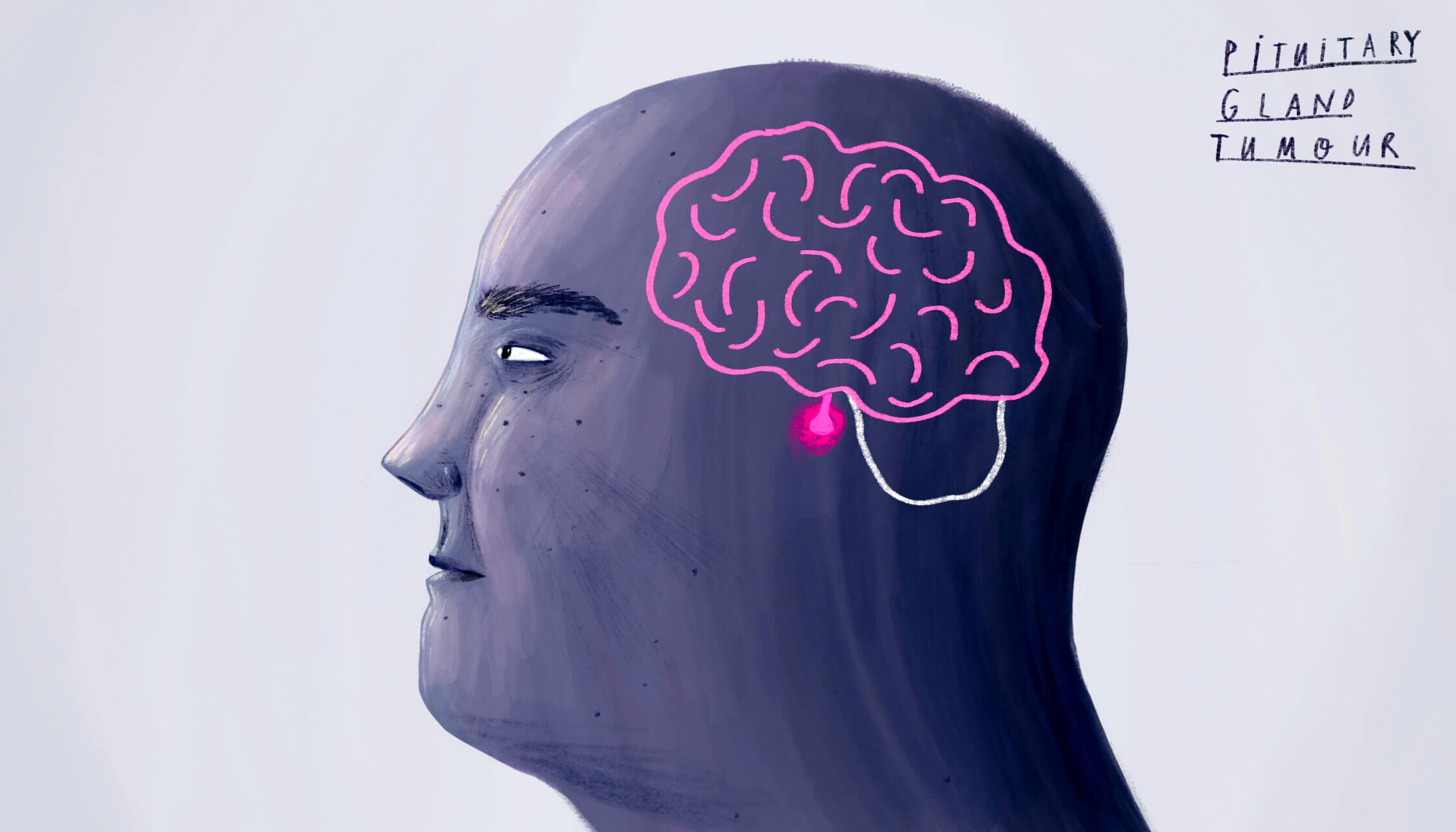Tumour in pituitary gland

Neurosurgeon Brisbane
Tumour in pituitary gland key points
- The main role of the pituitary gland is to produce most of the important hormones the body needs to work properly.
- Pituitary tumours are dangerous. They can threaten vision over time, and lead to severe health problems, and even death.
- A combination of surgery, drug treatment and x-ray treatment is often required.
- On occasion these tumours are left alone and simply watched. But you will need to get this recommendation only from a specialist.
Definition pituitary gland tumour | Neurosurgeon Brisbane
What is it?
The pituitary is a small gland that sits in the middle of your head, just behind your eyes. Its main role is to produce most of the important hormones the body needs to work properly.
The hormones it produces are:
- Prolactin, which allows mothers to breastfeed newborns
- Growth hormone, important for your normal height and weight
- ACTH, important for allowing your body to deal with stress and exercise
- TSH, important for finetuning your metabolism
- LH and FSH, important for being able to have children
- ADH, important for finetuning your water levels
Each hormone type is produced by a separate group of cells within the pituitary gland. All these different cell types are all jammed into the pituitary gland together.
And it is from these individual groups that the tumours can arise.
As a result these tumours also produce hormones. And because they are tumour cells, they do not respond to the normal normal control signals of the body. They are rogue cells.

Neurosurgeon Brisbane
Interestingly, because the tumours come from cells that have a genetic mutation, the hormone that the tumour produces also has a mutation. Because the hormone is not normal it often has no effect on the body. It is like the wrong key for all the hormone locks in the body. We call these pituitary tumours ‘non functional’ because the hormones they produce have no functional effects on the body.
This is by far the most common tumour type, the so-called ‘non-functional pituitary adenoma.”
The less common tumours are the ‘functional’ types. In these tumours, while the cell itself is mutated, the hormone still comes out normal. And because the tumour cell is rogue, i.e. does not respond to normal body signals, the tumour pumps out a huge amount of the hormone, much much more than the body actually needs. It is this big excess of hormones that causes all the problems.
This is actually quite dangerous. Patients can develop very serious medical problems from this excess hormone. There is a risk that the patient could also die from this. Urgent treatment is always required.
It is the 4th most common brain tumour that a neurosurgeon sees in their career.
Pituitary gland tumour symptoms
What are the symptoms?
There are two ways that a pituitary tumours cause symptoms:
- Mass effect symptoms are due to the tumour growing large enough to compress and damage important nearby structures in the brain. The two most important are the pituitary gland itself and the vision nerves. If the remaining normal pituitary gland gets squashed it can stop working properly and stop producing vital hormones. If the vision nerves get squashed then the patient can go blind.
- Endocrinological symptoms are caused when the excess hormone produced by the tumour is the normal type. This hormone then reeks havoc by over stimulating all the normal targets in the body for that type of hormone. This is what happens when the different hormones are produced in excess by a tumour:
- Prolactin. The tumours that arise from the prolactin group of cells are called prolactinomas and pump out a massive amount of excess prolactin. High prolactin in women causes infertility and in men it also causes infertility. In both men and women it also causes galactorrhea: leaking from the nipples. This is a classic sign.
- Growth hormone. The tumours that arise from these call groups in the pituitary gland produce an excess of growth hormones. This causes the body parts to grow disproportionately large, and the condition is called acromegaly. Most noticable is a large square face, large nose, big hands and feet.
- ACTH. These tumours produce an excess of ACTH. This leads to a condition called Cushing’s Disease, named after the most famous neurosurgeon in the world, Mr Harvey Cushing who described it. This is a very dangerous condition if left untreated. It causes thin fragile skin, fat to build in your cheeks and around your neck and tummy, skinny legs and arms, and recurrent infections and diabetes.
- TSH and LH/FSH secreting tumours are very rare.
There is nothing that you did to cause it and nothing you could have done to prevent it. It’s down to bad luck.
Fortunately, it is not something you inherited off your parents and not something that you will pass onto your children.
Yes, and that is why these tumours need prompt treatment by a specialist. If you would like me to see your case then contact my team as soon as you can.
Pituitary gland tumour surgery
How is it treated?
A combination of surgery, drug treatment and x-ray treatment is often required. Once I have examined you, your scans and blood tests, I will be able to let you know exactly what type of treatment will be the absolute best for you.
Dr Alex Koefman, Neurosurgeon Brisbane
Do I need surgery?
Surgery is required for one of these three reasons:
- To get a diagnosis.
By looking at the scans and blood tests it is possible to determine what type of tumour you have without surgery. But on occasion it is not clear and so surgery sometimes needs to be performed just to get some specimen to send it off for tests to find out exactly what it is. - To relieve symptoms of pressure.
If the tumour is pressing on the vision nerves or compressing the remaining pituitary gland then surgery is required to remove the pressure to hopefully save your vision and the pituitary gland. This is a very common reason to need to perform surgery. - Oncological.
This means trying to get a cure. In the case of pituitary tumours it is possible to get a cure by removing the entire tumour. This is a very important goal of surgery, and why it is important to have a pituitary specialist perform the surgery as the area is to achieve this more often than a non-specialist.
The treatment is very effective. The key is to get onto it quickly.
Is this treatment safe?
The surgery is very modern and keyhole in nature. This may surprise you but the surgery is done up the nose with a telescope. When you wake up you won’t even look any different because everything is performed inside the nose. The nose itself does not get altered in shape or size as a result.

Neurosurgeon Brisbane
Despite the modern technology and technique there are risks that you will need to know about. These are:
- Risk that not all the tumour can be removed
- Risk that the tumour may reoccur further down the track
- Risk of infection or bleeding (rare)
- Risk of brain fluid leak through the nose (rare)
- You will feel like you have a cold for about a week, with a stuffy nose due to the surgery. This quickly returns back to normal.
On occasion these tumours are left alone and simply watched. But you will need to get this from a specialist, rather than make that decision on your own. A specialist is trained to determine if the tumour is likely to be a threat to your health. If you would like me to give you a specialty review of your case then please contact my team.
There is nothing you can do. This will come down to your treatment. How successful the surgery was, what type of tumour it is and whether you need drug or x-ray treatment also. It is complex and there are many factors to consider. Please contact my team if you would like me to make this assessment for you.
The cure rate is reasonably good in specialist hands.
Brain surgeon Brisbane
What should I do now?
If you have been diagnosed with a pituitary gland tumour, then you will likely have been referred for a specialist review already. If you would like me to review your case for a specialist opinion and treatment then please contact my team.
Ready to make an appointment?
Ramsay Specialist Centre
Suite 325
Newdegate St
Greenslopes QLD 4120

